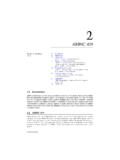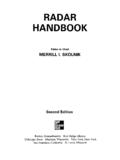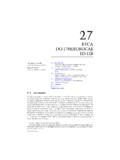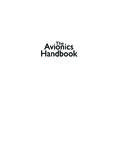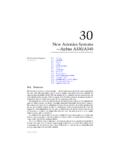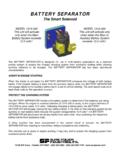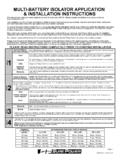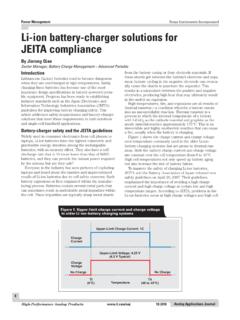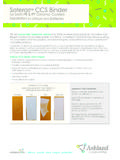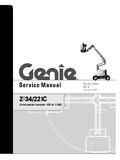Transcription of Batteries - davi.ws
1 2001 by CRC Press LLC 10 Batteries Int roduction General Principles battery Fundamentals Lead-Acid Batteries Theory of Operation Cell Construction battery Construction Discharge Performance Charge Methods Temperature Effects and Limitations Service Life Storage Characteristics Maintenance Requirements Failure Modes and Fault Detection Disposal Nickel-Cadmium Batteries Theory of Operation Cell Construction battery Construction Discharge Performance Charge Methods Temperature Effects and Limitations Service Life Storage Characteristics Maintenance requirements Failure Modes and Fault Detection Disposal Applications Commercial Aircraft Military Aircraft Defining Terms References Further Information Introduction The battery is an essential component of almost all aircraft electrical systems.
2 Batteries are used to startengines and auxiliary power units, to provide emergency backup power for essential avionics equipment,to assure no-break power for navigation units and fly-by-wire computers, and to provide ground powercapability for maintenance and preflight checkouts. Many of these functions are mission critical, so theperformance and reliability of an aircraft battery is of considerable importance. Other important require-ments include environmental ruggedness, a wide operating temperature range, ease of maintenance, rapidrecharge capability, and tolerance to , only a few types of Batteries have been found to be suitable for aircraft applications.
3 Untilthe 1950s, vented lead-acid (VLA) Batteries were used exclusively [Earwicker, 1956]. In the late 1950s,military aircraft began converting to vented nickel-cadmium (VNC) Batteries , primarily because of theirsuperior performance at low temperature. The VNC battery subsequently found widespread use in bothmilitary and commercial aircraft [Fleischer, 1956; Falk and Salkind, 1969]. The only other type of batteryused during this era was the vented silver-zinc battery , which provided an energy density about threetimes higher than VLA and VNC Batteries [Miller and Schiffer, 1971].
4 This battery type was applied toseveral types of Air Force fighters (F-84, F-105, and F-106) and Navy helicopters (H-2, H-13,and H-43) in the 1950s and 1960s. Although silver-zinc aircraft Batteries were attractive for reducingweight and size, their use has been discontinued due to poor reliability and high cost of ownership. David G. Vutetakis Douglas battery Co. 2001 by CRC Press LLC In the late 1960s and early 1970s, an extensive development program was conducted by the AirForce and Gulton Industries to qualify sealed nickel-cadmium (SNC) aircraft Batteries for military andcommercial applications [McWhorter and Bishop, 1972].
5 This battery technology was successfully dem-onstrated on a Boeing KC-135, a Boeing 727, and a UH-1F helicopter. Before the technology could betransitioned into production, however, Gulton Industries was taken over by SAFT and a decision wasmade to terminate the the late 1970s and early 1980s, the Navy pioneered the development of sealed lead-acid (SLA) Batteries for aircraft applications [Senderak and Goodman, 1981]. SLA Batteries were initially applied tothe AV-8B and F/A-18, resulting in a significant reliability and maintainability (R&M) improvementcompared with VLA and VNC Batteries .
6 The Navy subsequently converted the C-130, H-46, and P-3 toSLA Batteries . The Air Force followed the Navy s lead, converting numerous aircraft to SLA Batteries ,including the A-7, B-1B, C-130, C-141, KC-135, F-4, and F-117 [Vutetakis, 1994]. The term HighReliability, Maintenance-Free battery , or HRMFB, was coined to emphasize the improved R&M capabilityof sealed-cell aircraft Batteries . The use of HRMFBs soon spun off into the commercial sector, andnumerous commercial and general aviation aircraft today have been retrofitted with SLA the mid-1980s, spurred by increasing demands for HRMFB technology, a renewed interest in SNCbatteries took place.
7 A program to develop advanced SNC Batteries was initiated by the Air Force,and Eagle-Picher Industries was contracted for this effort [Flake, 1988; Johnson et al., 1994]. The B-52bomber was the first aircraft to retrofit this technology. SNC Batteries also have been developed by ACMEfor several aircraft applications, including the F-16 fighter, Apache AH-64 helicopter, MD-90, and Boeing777 [Anderman, 1994]. A recent development in aircraft Batteries is the low maintenance or ultra-low maintenance nickel-cadmium battery [Scardaville and Newman, 1993].
8 This battery is intended to be a direct replacementof conventional VNC Batteries , avoiding the need to replace or modify the charging system. Althoughthe battery still requires scheduled maintenance for electrolyte filling, the maintenance frequency can bedecreased significantly. This type of battery has been under development by SAFT and more recently byMarathon. Limited flight tests have been performed by the Navy on the H-1 helicopter. Applicationof this technology to commercial aircraft is also being the most suitable battery type and size for a given aircraft type requires detailed knowledgeof the application requirements (load profile, duty cycle, environmental factors, and physical constraints)and the characteristics of available Batteries (performance capabilities, charging requirements, life expect-ancy, and cost of ownership).
9 With the various battery types available today, considerable expertise isrequired to size, select, and prepare technical specifications. The information contained in this chapterwill provide general guidance for original equipment design and for upgrading existing aircraft detailed information can be found in the sources listed at the end of the chapter. General Principles battery Fundamentals Batteries operate by converting chemical energy into electrical energy through electrochemical dischargereactions. Batteries are composed of one or more cells, each containing a positive electrode, negativeelectrode, separator, and electrolyte.
10 Cells can be divided into two major classes: primary and cells are not rechargeable and must be replaced once the reactants are depleted. Secondary cellsare rechargeable and require a DC charging source to restore reactants to their fully charged of primary cells include carbon-zinc (Leclanche or dry cell), alkaline-manganese, mercury-zinc, silver-zinc, and lithium cells ( , lithium-manganese dioxide, lithium-sulfur dioxide, and lithium-thionyl chloride). Examples of secondary cells include lead-lead dioxide (lead-acid), nickel-cadmium,nickel-iron, nickel-hydrogen, nickel-metal hydride, silver-zinc, silver-cadmium, and lithium-ion.

